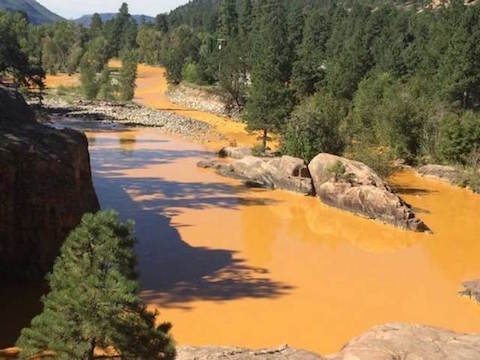The recent spill of toxic mine waste into the Animas River in Colorado has elevated the threats of mining to our precious rivers to the forefront of national news, perhaps a silver lining to the tragedy. Aside from the extraordinary conservation values of our rivers, the spill may be one of the most powerful arguments in our communities against the proposed nickel mines in Southwest Oregon.
See bottom of post for ways to engage and info on September 9th public meeting in Gold Beach.
Luckily some in the media are getting to the root of the problem—the 1872 Mining Law and the irresponsibility of the mining industry—the focus of the recent editorial in the New York Times (
linked here) and a good primer from the Crag Law Center
located here.

Toxic Sludge Fills the Animas River
The toxic plume from the abandoned Gold King Mine occurred on a tributary of the Animas River. It was the result of the build up of “acid mine drainage (AMD).". The
abandoned Formosa Mine in Douglas County (an EPA Superfund site) is an example of AMD pollution. However, most of the area of the proposed Southwest Oregon withdrawal area does not have a mineral composition conducive to AMD
but it has other issues. Examples are: naturally occurring asbestos, potential chromium VI pollution, nickel, other toxic metals, fugitive dust and other air pollution.

Toxic Pool at the Formosa Mine in Douglas County
And there is some indication there could be AMD issues in the Red Flat area. Plus the Turner-Albright deposit, adjacent to the proposed withdrawal area (in the West Fork Illinois River watershed), is a sulphide deposit capable of producing AMD. That said, we don’t know whether that part of the withdrawal area has underlying sulphide bearing rock.
Metal mining is the most polluting industry in the U.S. Remember EPA’s numbers from their most recent toxic release inventory - just 88 metal mine facilities produce 47 percent of all toxic pollution in the United States.
Read more here.
In April of this year, American Rivers named the Rogue and Smith Rivers to their
America’s 10 Most Endangered Rivers list because of the mining proposed at Rough and Ready Creek and in the watershed of the North Fork Smith River. To some it seemed a stretch to say the Rogue (very roughly sixty-some miles as a fish swims from where Rough and Ready Creek enters the West Fork Illinois River) could be endangered by a mine and smelter operation at this beloved creek and community open space.

The Rogue River - a very important place for salmon, steelhead, wildlife viewing and recreational opportunities
We’ve just learned the toxic plume from the abandoned Gold King Mine has now traveled about 100 miles across parts of three states. The Gasquet, Hiouchi, Gold Beach, Crescent City, Cave Junction, Pistol River and the Hunter Creek communities are all closer than this to nickel mining proposals in Southwest Oregon.
The Gold King Mine spill is not an anomaly. Abandoned and operating mines have long been responsible for polluting rivers and streams. Last year in August the tailings lake at the relatively modern Mount Polley Mine breached sending millions of cubic meters of mine waste into relatively pristine lakes and waterways in British Columbia. In the same month last year, an operating mine facility leaked toxic chemicals into waterways in Mexico. The modern Goro nickel laterite mine in New Caledonia has had major pollution problems. Read more here Then there's been the pollution of rivers and the drinking water of thousands in North Carolina and West Virginia relating to coal mining.
Our rivers provide some of the purest water in the country because they flow from wilderness, roadless areas and otherwise undeveloped National Forest and BLM managed lands. The proposed mineral withdrawals are right now the best chance we have of keeping it that way. Why? Because it’s the land managing agencies’ position that unless an area is withdrawn from operation of the 1872 Mining Law, they can’t say no to a reasonable mining proposal.
We now have at least a chance to say no to polluting mines and yes to preserving our rivers. It’s been over two decades in the making but we could lose it in a flash. We need to get these message across to our neighbors and communities and get them to support both the temporary and legislative mineral withdrawals.
Ways to Engage:
Gold Beach
When: Wednesday, Sept 9th, 2015 - 5pm-8pm
Where: Curry County Fairgrounds, Docia Sweet Hall, 29392 Ellensburg Ave, Gold Beach, OR
When: Must be Submitted by September 28th




